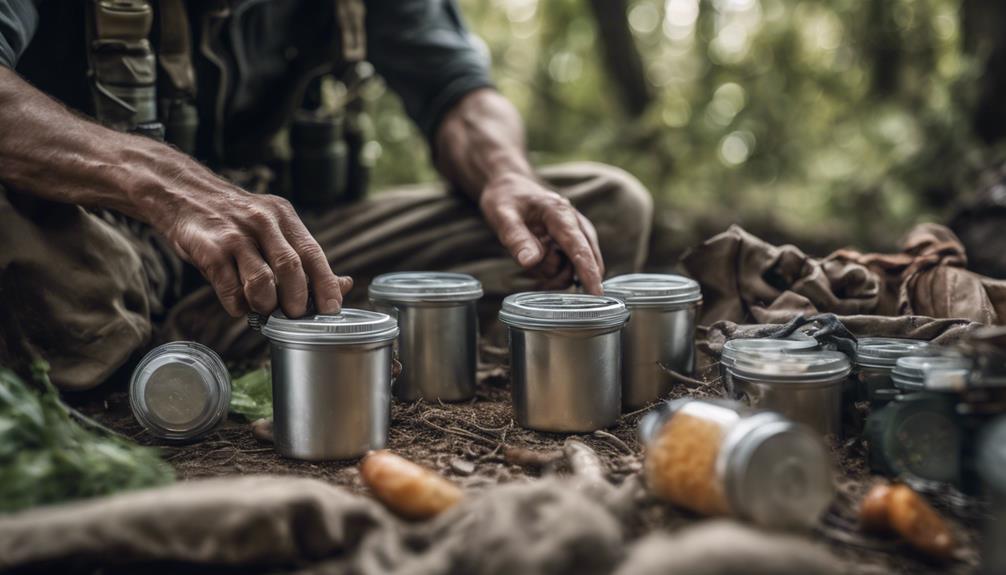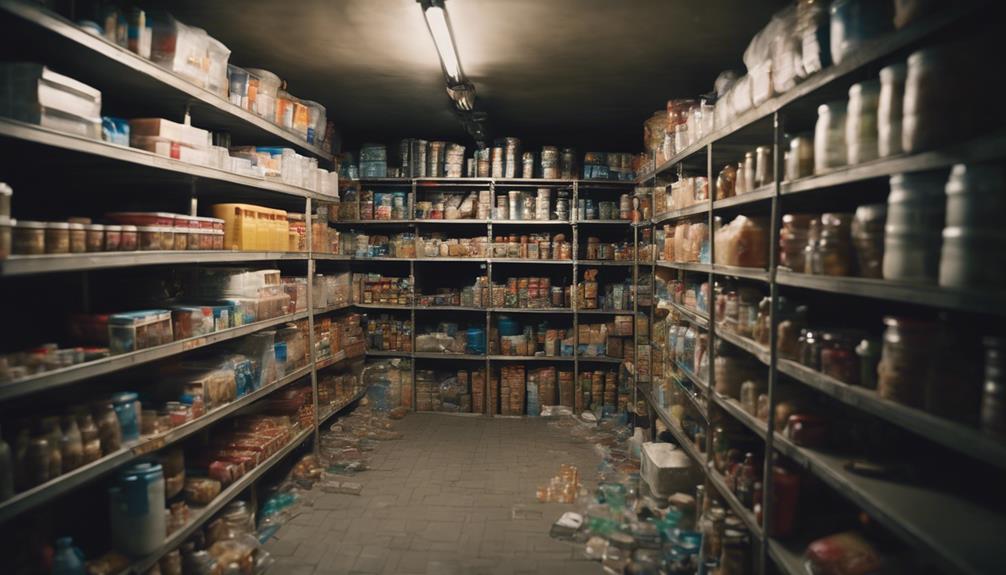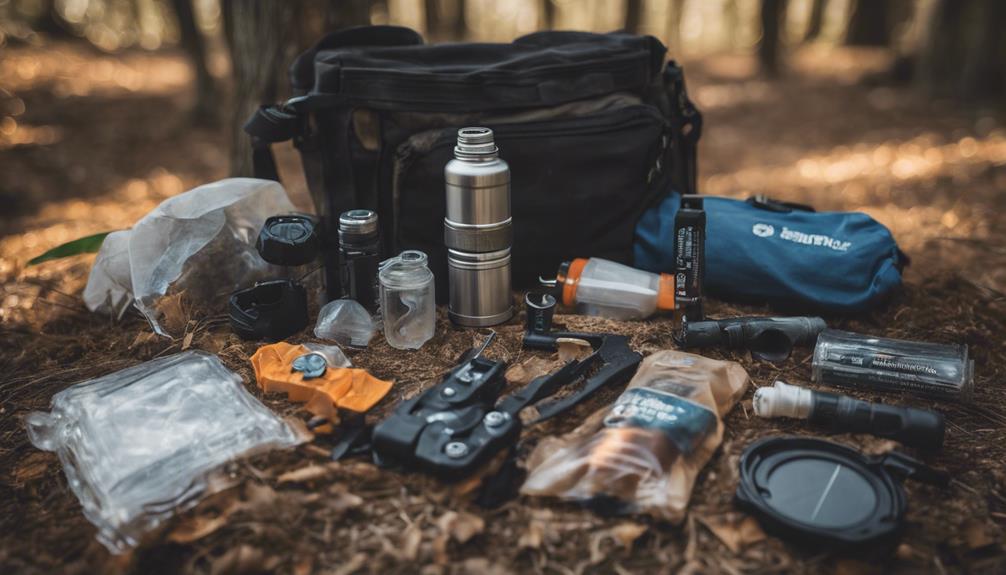Mormon survival food emphasizes faith-driven, long-term food storage to guarantee you're prepared for life's uncertainties. You should focus on low-moisture foods like wheat, rice, and beans, which can last up to 30 years. Regularly check your supplies for moisture and quality, as proper packaging in airtight containers is vital. Aim for a three-month supply that reflects your normal diet, gradually expanding over time. Water is equally important, so plan for at least a gallon per person per day. There's so much more to optimizing your preparedness strategy, allowing you to confidently face the unexpected challenges ahead.
Key Takeaways
- Emphasize low-moisture foods like wheat, rice, and beans for long-term storage, aligning with faith-focused preparedness principles.
- Maintain a three-month supply of essentials, ensuring access to nutritious meals during emergencies or unforeseen circumstances.
- Utilize airtight containers and oxygen absorbers to enhance food preservation and extend shelf life up to 30 years.
- Regularly check storage conditions and rotate supplies to maintain freshness and quality, reflecting self-reliance values.
- Incorporate financial preparedness by saving and budgeting, fostering a holistic approach to emergency readiness within the faith community.
Importance of Long-Term Food Storage

Long-term food storage is crucial for guaranteeing you have access to nutritious meals during emergencies or unforeseen circumstances. By focusing on low-moisture foods like wheat, rice, and beans, you can maintain a food supply that lasts for 30 years or more.
These items, when properly packaged and stored, become a reliable part of your emergency preparedness plan. The Church of Jesus Christ emphasizes the importance of self-reliance, and having a well-stocked food reserve is a key element of that philosophy.
To create a balanced long-term food supply, aim for recommended amounts like 25 lbs of grains and 5 lbs of dry beans per adult. Using airtight containers, such as food-grade plastic buckets with gasketed lids, protects your stored food from moisture and pests, crucial for preserving its integrity. Additionally, understanding the financial considerations related to food storage can help you budget effectively for your long-term preparedness efforts.
Regularly evaluating your food items for moisture and quality guarantees they remain safe and nutritious for consumption. By investing time and effort into long-term storage, you're not just building a financial reserve; you're securing peace of mind and the ability to provide for yourself and your loved ones, no matter what challenges arise.
Recommended Foods for Storage

When it comes to building your long-term food storage, focusing on nutrient-rich staples can set you up for success. The LDS Church emphasizes the importance of having a well-stocked supply for emergencies, and selecting the right basic foods is essential. Here are some recommended foods for storage that offer impressive shelf life and nutritional value:
| Food Item | Shelf Life |
|---|---|
| Wheat | 20-30 years |
| Rice | 20-30 years |
| Dry Beans | 20-30 years |
| Canned Goods | Up to 30 years |
| Dehydrated Fruits/Vegetables | Varies, but long-lasting |
Low-moisture foods like sugar and salt also excel in long-term storage, remaining nutritious for decades. Canned goods provide ready-to-eat options, making them practical during emergencies. Confirm that dehydrated fruits and vegetables are sufficiently dry to maintain their quality. Regularly evaluating your food items for moisture and integrity is essential to keeping your long-term food storage supply safe. By focusing on these recommended foods, you'll be better prepared for whatever challenges come your way.
Effective Packaging Techniques

Proper packaging techniques play a pivotal role in maintaining the quality and safety of your stored food. By utilizing effective packaging methods, you can guarantee your items stay fresh for long-term storage.
Start with achieving an airtight seal to keep moisture and air out, which can lead to spoilage. Here are some key techniques you should consider:
- Use foil pouches for dry products, sealing them with an impulse sealer for an airtight fit.
- Opt for PETE bottles or food-grade plastic buckets for bulk storage.
- Incorporate oxygen absorber packets in your packaging to enhance food preservation and prevent insect infestations.
- Keep the moisture content of your dry products at 10% or less before sealing to reduce spoilage risks.
- Regularly inspect your stored items for any air leaks or moisture presence, as these can compromise safety. Additionally, maintaining good air quality in your storage area can further enhance food preservation and safety, as indoor air quality impacts the longevity of stored items.
Optimal Storage Conditions

To keep your survival food in prime shape, aim for a storage temperature of 75°F (24°C) or cooler.
It's also important to control moisture levels and protect your food from light, which can degrade quality over time.
Ideal Temperature Range
Maintaining an ideal storage temperature is essential for preserving the integrity of your long-term food supplies. The best temperature for storing food is 75°F (24°C) or lower. This guarantees maximum shelf life and helps prevent the degradation of your provisions.
To achieve the finest conditions for your supplies, consider the following:
- Store food in a cool, dry place.
- Keep containers elevated at least ½ inch (1.3 cm) off the floor to allow for air circulation.
- Protect sensitive items like cooking oil from light exposure.
- Regularly check your storage conditions to confirm they remain consistent.
- Monitor for any signs of moisture damage, which can lead to spoilage.
Moisture Control Strategies
Controlling moisture is vital for preserving your survival food supplies and guaranteeing they remain safe to eat. To achieve effective moisture control, start by storing dry food products with 10% or less moisture content. This prevents spoilage and contamination.
For ideal storage conditions, maintain a temperature of 75°F (24°C) or lower, and keep your storage area dry.
Using airtight containers, like food-grade plastic buckets with gasketed lids, is important for minimizing moisture exposure. These containers also help prevent pest infestations, which can compromise your longer-term storage.
Make it a habit to regularly assess your stored food items for moisture and overall quality. High moisture levels can lead to mold growth and nutrient degradation, so vigilance is key.
Another effective strategy is to elevate your storage containers off concrete floors by at least ½ inch (1.3 cm). This simple step enhances air circulation and further helps control moisture levels around your stored food.
Light Protection Techniques
While moisture control is key to keeping your survival food safe, protecting your supplies from light exposure is just as important.
Light can degrade oils and packaged foods, impacting their nutritional integrity over time. To guarantee your food storage remains effective, consider these techniques:
- Use opaque or dark containers for sensitive items.
- Store food in cool, dry, and dark areas.
- Regularly inspect storage spaces for direct sunlight exposure.
- Utilize airtight packaging to shield from moisture and pests.
- Rotate supplies periodically to maintain freshness.
Emergency Preparedness Resources

When it comes to emergency preparedness, having the right resources can make all the difference.
You'll want to explore essential emergency kits, understand financial preparedness principles, and follow effective food storage recommendations. Additionally, incorporating options like a Bitcoin IRA can provide a hedge against economic uncertainty.
With these tools, you can create a solid plan that keeps you and your family ready for any situation.
Essential Emergency Kits
Preparing an essential emergency kit is a significant step in ensuring your safety during unexpected situations. Your kit should be designed to last at least 72 hours and include important supplies for survival.
Focus on food storage and water storage, as hydration is just as important as sustenance in your emergency preparedness plan.
Here are five essential items to include in your emergency kit:
- At least one gallon of water per person per day
- A variety of long-term food storage options like freeze-dried meals or canned goods
- A first aid kit with basic medical supplies
- A flashlight with extra batteries
- Personal documents and hygiene supplies
Make sure to regularly update your essential emergency kits and check the expiration dates on food and medical supplies.
Additionally, consider utilizing community resources such as local food preservation and canning centers to enhance your food storage options.
By preparing now, you'll have peace of mind knowing you're ready for whatever comes your way.
Financial Preparedness Principles
Financial preparedness is an essential aspect of overall emergency readiness that often gets overlooked. The Church encourages its members to focus on living within their means and saving excess funds to enhance their overall preparedness.
One of the initial steps you can take is setting financial goals, such as saving one month's salary. This not only gives you a financial cushion but also builds a sense of security.
Having a financial reserve is important for steering through crises without incurring debt or unnecessary expenditures. Regular budgeting and attending financial seminars can reinforce the importance of financial discipline, ensuring you're ready for emergencies.
While you're preparing your emergency kits, remember that financial preparedness goes hand-in-hand with having food that will last and basic staples on hand.
Additionally, consider diversifying your financial reserves, including alternative currencies like gold or silver, to provide long-term stability and security. Gold IRAs can serve as a strategic option for enhancing your financial resilience.
Food Storage Recommendations
To guarantee your family's readiness for emergencies, it's essential to focus on effective food storage strategies. Start by prioritizing long-term storage options that consist of low-moisture foods like wheat, rice, and beans. These can last 20-30 years if stored properly with 10% or less moisture content.
Here are some key recommendations to help you get started:
- Use airtight containers such as foil pouches, PETE bottles, and food-grade plastic buckets.
- Regularly check for moisture and quality, and rotate your supplies to maintain freshness.
- Aim for a three-month supply that reflects your normal daily diet, gradually increasing to a year or more.
- Explore canning and preservation techniques to supplement your stored items.
- Consider purchasing pre-packaged food storage items from local grocery stores or LDS Church home storage centers.
Don't forget about your water supply; it's just as important as food preservation. Additionally, incorporating renewable energy sources can enhance your preparedness by providing sustainable solutions for food storage and preservation.
Building a Food Storage Plan

A solid food storage plan starts with understanding your family's dietary needs and preferences. Begin by storing a three-month supply of food that reflects your normal daily diet. You can gradually build a supply by purchasing extra items each week, ensuring variety and nutritional balance. Focus on long-term storage staples, such as wheat, rice, and beans, which can last 20-30 years when stored properly.
| Food Type | Shelf Life (Years) | Storage Method |
|---|---|---|
| Wheat | 20-30 | Airtight containers |
| Rice | 20-30 | Airtight containers |
| Canned Goods | Up to 30 | Local canning centers |
| Beans | 20-30 | Airtight containers |
Utilize local canning centers for preservation and stockpiling, as canned goods provide ready-to-eat options in emergencies. Regularly rotate your stockpile to prevent spoilage, ensuring shorter-term food items are used before their expiration dates. Finally, maintain an inventory list of stored food items, checking expiration dates and quality to keep your food storage effective and ready for use during emergencies. Understanding the importance of long-term survival foods can significantly enhance your preparedness efforts.
Frequently Asked Questions
Why Do Mormons Prep Food?
You prep food as a way to guarantee your family's well-being during unpredictable events.
By maintaining a supply, you become self-reliant and ready for emergencies like natural disasters or economic hardships.
Storing staples like wheat, rice, and beans not only provides nutritional security but also fosters a sense of community resilience.
With the right knowledge and resources, you can effectively store food for the long term and protect your loved ones. By understanding proper preservation techniques, you can ensure that your meals remain safe and nutritious over time. Investing in 1 month food supply essentials is a practical way to start, as it allows you to have a variety of staple foods on hand for emergencies or unexpected situations. Additionally, learning about proper storage methods can help maximize the shelf life of your products, making your preparations even more effective.
Can You Buy Food From the LDS Cannery?
Imagine a sturdy ship, ready to weather any storm.
You can indeed buy food from LDS canneries, which serve as lifeboats of long-term sustenance. These centers offer a treasure trove of items like grains, beans, and dehydrated foods, all designed to last up to 30 years.
You can either grab pre-packaged goods or engage in hands-on canning sessions, ensuring you've got a solid supply for whatever life throws your way.
Are There Any Foods That Mormons Can't Eat?
Yes, there are certain foods that Mormons avoid. You won't find them consuming alcohol, tobacco, or illegal drugs, as these are against their health guidelines.
Strong drinks, like coffee and tea, are also off the table due to caffeine content. While they can eat meat, it's recommended to do so sparingly.
Additionally, foods high in sugar or harmful substances are generally avoided, promoting a diet rich in grains, fruits, and vegetables.
Which Survival Food Company Is Best?
When you're choosing the best survival food company, think about variety, shelf life, packaging, and nutrition.
Thrive Life offers diverse options, while Augason Farms focuses on affordability. Mountain House specializes in tasty freeze-dried meals.
Compare customer reviews to gauge quality and flavor. Remember, the right choice guarantees you've got a balanced diet during emergencies, keeping you prepared and confident in your food supply.
It's all about meeting your unique needs!
Conclusion
Incorporating Mormon principles into your survival food storage isn't just practical; it's a demonstration of faith in uncertain times. Did you know that nearly 60% of American households don't have a three-day supply of food? By taking proactive steps in building your food storage plan, you not only prepare for emergencies but also cultivate peace of mind. Start today, embrace the journey, and remember: it's not just about food; it's about faith and readiness for the future!










